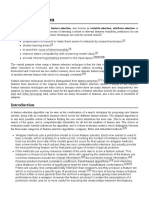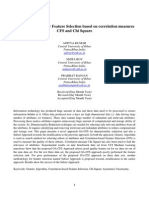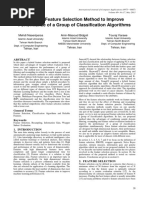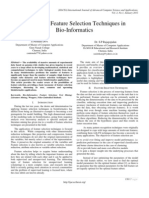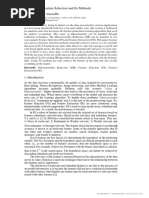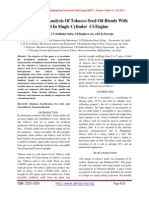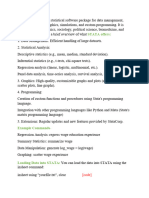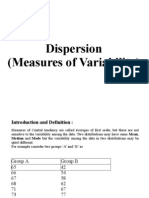0 ratings0% found this document useful (0 votes)
45 viewsFeature Subset Selection With Fast Algorithm Implementation
The Title “Feature Subset Selection with FAST Algorithm Implementation” has intended to show the things
occurred in between the searches happened in the place of client and server. The users clearly know about the process of
how to sending a request for the particular thing, and how to get a response for that request or how the system shows the
results explicitly. But no one knows about the internal process of searching records from a large database. This system
clearly shows how an internal process of the searching process works. In text classification, the dimensionality of the
feature vector is usually huge to manage. The Problems need to be handled are as follows: a) the current problem of the
existing feature clustering methods b) The desired number of extracted features has to be specified in advance c) When
calculating similarities, the variance of the underlying cluster is not considered d) How to reduce the dimensionality of
feature vectors for text classification and run faster. These Problems are handled by means of applying the FAST
Algorithm in hands with Association Rule Mining.
Uploaded by
seventhsensegroupCopyright
© © All Rights Reserved
Available Formats
Download as PDF, TXT or read online on Scribd
0 ratings0% found this document useful (0 votes)
45 viewsFeature Subset Selection With Fast Algorithm Implementation
The Title “Feature Subset Selection with FAST Algorithm Implementation” has intended to show the things
occurred in between the searches happened in the place of client and server. The users clearly know about the process of
how to sending a request for the particular thing, and how to get a response for that request or how the system shows the
results explicitly. But no one knows about the internal process of searching records from a large database. This system
clearly shows how an internal process of the searching process works. In text classification, the dimensionality of the
feature vector is usually huge to manage. The Problems need to be handled are as follows: a) the current problem of the
existing feature clustering methods b) The desired number of extracted features has to be specified in advance c) When
calculating similarities, the variance of the underlying cluster is not considered d) How to reduce the dimensionality of
feature vectors for text classification and run faster. These Problems are handled by means of applying the FAST
Algorithm in hands with Association Rule Mining.
Uploaded by
seventhsensegroupCopyright
© © All Rights Reserved
Available Formats
Download as PDF, TXT or read online on Scribd
You are on page 1/ 5
International Journal of Computer Trends and Technology (IJCTT) volume 6 number 1 Dec 2013
ISSN: 2231-2803 http://www.ijcttjournal.org Page1
Feature Subset Selection with Fast Algorithm
Implementation
K.Suman
#1
, S.Thirumagal
#2
#1
M.E, Computer Science and Engg, Chendhuran College of Engg and Tech, Anna University, Tamilnadu, India
#2
Assistant Professor, Department of IT, Chendhuran College of Engg and Tech, Anna University, Tamilnadu, India
Abstract-- The Title Feature Subset Selection with FAST Algorithm Implementation has intended to show the things
occurred in between the searches happened in the place of client and server. The users clearly know about the process of
how to sending a request for the particular thing, and how to get a response for that request or how the system shows the
results explicitly. But no one knows about the internal process of searching records from a large database. This system
clearly shows how an internal process of the searching process works. In text classification, the dimensionality of the
feature vector is usually huge to manage. The Problems need to be handled are as follows: a) the current problem of the
existing feature clustering methods b) The desired number of extracted features has to be specified in advance c) When
calculating similarities, the variance of the underlying cluster is not considered d) How to reduce the dimensionality of
feature vectors for text classification and run faster. These Problems are handled by means of applying the FAST
Algorithm in hands with Association Rule Mining.
Index Terms FAST algorithm, Feature selection, Redundant data, Text classification, Clustering, Rule mining.
1. INTRODUCTION
In machine learning and statistics, feature selection also
known as variable selection, attribute selection or variable
subset selection. It is the process of selecting a subset of
relevant features for use in model construction. The central
assumption when using a feature selection technique is that the
data contains many redundant or irrelevant features.
Redundant features are those which provide no more
information than the currently selected features, and irrelevant
features provide no useful information in any context. Feature
selection techniques are a subset of the more general field
of feature extraction. Feature extraction creates new features
from functions of the original features, whereas feature
selection returns a subset of the features. Feature selection
techniques are often used in domains where there are many
features and comparatively few samples or data points. The
archetypal case is the use of feature selection in
analysing DNA microarrays, where there are many thousands
of features, and a few tens to hundreds of samples. Feature
selection techniques provide three main benefits when
constructing predictive models: improved model
interpretability, shorter training times, and enhanced by
reducing over fitting.
A feature selection algorithmcan be seen as the combination
of a search technique for proposing new feature subsets, along
with an evaluation measure which scores the different feature
subsets. The simplest algorithmis to test each possible subset
of features finding the one which minimizes the error rate.
This is an exhaustive search of the space, and is
computationally intractable for all but the smallest of feature
sets. The choice of evaluation metric heavily influences the
algorithm, and it is these evaluation metrics which distinguish
between the three main categories of feature selection
algorithms: wrappers, filters and embedded methods.
Wrapper methods use a predictive model to score feature
subsets. Each new subset is used to train a model, which is
tested on a hold-out set. Counting the number of mistakes
made on that hold-out set (the error rate of the model) gives
the score for that subset. As wrapper methods train a new
model for each subset, they are very computationally
intensive, but usually provide the best performing feature set
for that particular type of model.
Filter methods use a proxy measure instead of the error rate to
score a feature subset. This measure is chosen to be fast to
compute, whilst still capturing the usefulness of the feature
set. Common measures include the Mutual
Information, Pearson product-moment correlation coefficient,
and inter/intra class distance. Filters are usually less
computationally intensive than wrappers, but they produce a
feature set which is not tuned to a specific type of predictive
model. Many filters provide a feature ranking rather than an
explicit best feature subset, and the cutoff point in the ranking
is chosen via cross-validation.
Embedded methods are a catch-all group of techniques which
performfeature selection as part of the model construction
process. One other popular approach is the Recursive Feature
Elimination algorithm, commonly used with Support Vector
Machines to repeatedly construct a model and remove features
with low weights. These approaches tend to be between filters
and wrappers in terms of computational complexity.
Subset selection evaluates a subset of features as a group for
suitability. Subset selection algorithms can be broken into
Wrappers, Filters and Embedded. Wrappers use a search
algorithmto search through the space of possible features and
evaluate each subset by running a model on the subset.
International Journal of Computer Trends and Technology (IJCTT) volume 6 number 1 Dec 2013
ISSN: 2231-2803 http://www.ijcttjournal.org Page2
Wrappers can be computationally expensive and have a risk of
over fitting to the model. Filters are similar to Wrappers in the
search approach, but instead of evaluating against a model, a
simpler filter is evaluated. Embedded techniques are
embedded in and specific to a model.
The Fast clustering Based Feature Selection algorithm(FAST)
works into 2 steps. In the first step, features are divided into
clusters by using graph theoretic clustering methods. In the
second step, the most representative feature i.e., strongly
related to target class is selected fromeach cluster to form the
final subset of features. A feature in different clusters in
relatively independent, the clustering based strategy of FAST
has high probability of producing a subset of useful and
independent features. The experimental results show that,
compared with other five different types of feature subset
selection algorithms, the proposed algorithm not only reduces
the number of features, but also improves the performances of
four well known different types of classifiers. A good feature
subset is one that contains features highly correlated with the
target, yet uncorrelated with each other. Different fromthese
algorithms, our proposed FAST algorithmemploys clustering
based method to features.
This paper discusses about feature selection, FAST algorithm,
Text classification and so on. The next section is literature
review.
2. LITERATURE REVIEW
This section literature review has provides an overview and a
critical evaluation of a body of literature relating to a research
problem. Literature review is the most important step in
software development process. This paper presents [1], a
temporal association rule mining approach named T-patterns,
applied on highly challenging floating train data. The aimis to
discover temporal associations between pairs of time stamped
alarms, called events, which can predict the occurrence of
severe failures within a complex bursty environment. The main
advantage is Association Rule Mining Produces efficient
cluster wise data maintenance and main drawback of this paper
is cluster set is too large to handle. In this paper [2], an
algorithm for mining highly coherent rules that takes the
properties of propositional logic into consideration is proposed.
The derived association rules may thus be more thoughtful and
reliable. The advantage is reducing the Cluster set by applying
Feature subset manipulations and drawback is resulting
probability is low. In this paper [3], the basic objective of
feature subset selection is to reduce the dimensionality of the
problem while retaining the most discriminatory information
necessary for accurate classification. Thus it is necessary to
evaluate feature subsets for their ability to discriminate
different classes of pattern. Now the fact that two best features
do not comprise the best feature subset of two features
demands evaluation of all possible subset of features to find out
the best feature subset. If the number of features increases, the
number of possible feature subsets grows exponentially leading
to a combinatorial optimization problem. The advantage of this
paper is optimal subset is created, so less time is required for
manipulation and drawbacks are data security is an issue, high
possibility for data loss. In the instance of this paper [4], we
present here a new population-based feature selection method
that utilizes dependency between features to guide the search.
For the particular problem of feature selection, population-
based methods aim to produce betteror fitter future
generations that contain more informative subsets of features. It
is well-known that feature subset selection is a very
challenging optimization problem, especially when dealing
with datasets that contain large number of features. The main
advantage of this paper is applying subset classification
algorithmto simplify data and drawback is, it requires more
time to manipulate data. In this paper [5], we propose a new
hybrid ant colony optimization (ACO) algorithmfor feature
selection (FS), called ACOFS, using a neural network. A key
aspect of this algorithmis the selection of a subset of salient
features of reduced size. ACOFS uses a hybrid search
technique that combines the advantages of wrapper and filter
approaches. We evaluate the performance of ACOFS on eight
benchmark classification datasets and one gene expression
dataset, which have dimensions varying from 9 to 2000. The
advantage along with this paper is hybrid methodology is
applied to optimize data and other drawback is inefficient for
large data sets. According to this paper which presents [6], a
feature subset selection algorithmbased on branch and bound
techniques are developed to select the best subset of mfeatures
from an n-feature set. Existing procedures for feature subset
selection, such as sequential selection and dynamic
programming, do not guarantee optimality of the selected
feature subset. Exhaustive search, on the other hand, is
generally computationally unfeasible. The present algorithmis
very efficient and it selects the best subset without exhaustive
search. The advantage is, pointers are maintained to reach data
efficiently and drawback which among inner looping produces
lots and lots of confusions for large cluster.
3. PROPOSED APPROACH
In the Proposed Approach, the feature subset selection
algorithmthe data is to be viewed as the process of identifying
and eliminating as many immaterial and unneeded features as
probable. This is because inappropriate features do not supply
to the projecting accuracy and unneeded features do not
redound to getting a better predictor for that they provide
mostly information which is already present in other features.
In past systems users can store the data and retrieve the data
from server without any knowledge about how it is maintained
and how it gets processed, but in the present systemthe users
clearly know about the process of how to sending a request for
the particular thing, and how to get a response for that request
or how the system shows the results explicitly, but no one
knows about the internal process of searching records from a
large database. This systemclearly shows how an internal
process of the searching process works; this is the present
advantage in our system. In text classification, the
dimensionality of the feature vector is usually huge to manage.
In the present system we eliminate the redundant data finding
the representative data, reduce the dimensions of the feature
sets, find the best set of vectors which best separate the
patterns and two ways of doing feature reduction, feature
selection and feature extraction. Good feature subsets contain
features highly correlated with predictive of the class, yet
uncorrelated with each other. The efficiently and effectively
deal with both irrelevant and redundant features, and obtain a
good feature subset. In future the same system can be
International Journal of Computer Trends and Technology (IJCTT) volume 6 number 1 Dec 2013
ISSN: 2231-2803 http://www.ijcttjournal.org Page3
developed with the help of mobile applications to support the
same procedure in mobile environments so that the users can
easily manipulate their data in any place.
4. SYSTEM DESIGN
4.1 SYSTEM ARCHITECTURE
Generally algorithms shows a result for exploring a single
thing that is either be a performance, or speed, or accuracy,
and so on. But here is a requirement of proving the above
mentioned all in a single algorithm. The system has to start
with a concept of collecting transactional database, and
process the step with the rule of association, further
implementation proceeds with an implementation of rule
mining; then finally end with the process of sensitive rule
mining. For all our goal is to apply various association rules
to generate quicker results that may enhance algorithm
process.
Fig.a.SystemArchitecture
4.2 MODULES
A. User Module
B. Circulated Clustering
C. Text Detachment
D. Association Rule Mining
E. Text Organization
F. Data Representation
A. USER MODULE
In this module, Users are having authentication and security to
access the detail which is presented in the ontology system.
Before accessing or searching the details user should have the
account in that otherwise they should register first.
B. CIRCULATED CLUSTERING
Cluster is nothing but it is a combination of various features
including text subsets, it has been used to cluster words into
groups based either on their contribution in particular
grammatical relations with other words. Here the distributed
clustering focuses on the cluster with various text subsets. In
this module the systemcan manage the cluster with various
classifications of data.
C. TEXT DETACHMENT
The text detachment is the filtration process, which filters the
combination of various subsets present in the cluster into
matching clusters belonging to the text head with the help of
k-Means algorithm. A novel algorithmwhich can efficiently
and effectively deal with both inappropriate and superfluous
features, and acquire a good feature subset.
.
D. ASSOCIATION RULE MINING
Association rule mining is the best method for discovering
interesting relations between variables in large databases or
data warehouse. It is intended to identify strong rules
discovered in databases using different measures of
interestingness. With the help of this rule mining the system
can manipulate and associates the text cluster into the
respective heads based on the internal features of data.
E. TEXT ORGANIZATION
The Text organization contains many problems, which has
been widely studied in the data mining, machine learning,
database, and information retrieval communities with
applications in a number of diverse domains, such as target
marketing, medical diagnosis, news group ltering, and
document organization. The text organization technique
assumes categorical values for the labels, though it is possible
to use continuous values as labels. The latter is referred to as
the regression modeling problem. The problem of text
organization is closely related to that of classication of
records with set-valued features. However, this model assumes
that only information about the presence or absence of words
is used in a document. In reality, the frequency of words also
plays a helpful role in the classication process and typical
domain size of text data (the entire size) is much greater than a
typical set valued classication problem.
F. DATA REPRESENTATION
With the help of text classification and association rule mining
the cluster is assembled with proper subset and correct header
representations, in this stage the system can easily find out the
text representation with maximumthreshold value.
4.3 SCREEN SHOTS
A. Main form
Authentication
Load Transactional
database
Authorization
Newreg
Registry created
DB- System
Request dataand
receive response
Client
User
International Journal of Computer Trends and Technology (IJCTT) volume 6 number 1 Dec 2013
ISSN: 2231-2803 http://www.ijcttjournal.org Page4
B. Load Transactional Data
C. Select the Data
D. Text Classification
International Journal of Computer Trends and Technology (IJCTT) volume 6 number 1 Dec 2013
ISSN: 2231-2803 http://www.ijcttjournal.org Page5
S.Thirumagal is currently working as an
Asst. Prof. from the Department of
Information Technology at Chendhuran
College of Engineering and Technology,
Pudukkottai. She received his Bachelor
Degree from Shanmuganathan Engineering
College, Pudukkottai. She received his
master degree fromInfant J esus college of
Engineering, Thoothukudi and Tamilnadu.
She Published 1 National Conference and 1
International J ournal. Her main research
interests lie in the area of Data mining and
Data warehousing.
5. CONCLUSION AND FUTURE ENHANCEMENT
For the entire Fast algorithmin hands with association rule
implementation gives flexible results to users, like removing
irrelevant features fromthe Original Subset, and constructing
a minimumspanning tree from the relative subset whatever
present in the data store. By partitioning the minimum
spanning tree we can easily identify the text representation
fromthe features. Association Rule Mining gives ultimate data
set with header representation as well as FAST algorithm with
applied K-Means strategy provides efficient data management
and faster performance. The revealing regulation set is
significantly smaller than the association rule set, in particular
when the minimumsupport is small. The proposed work has
characterized the associations between the revealing
regulation set and the non-redundant association rule set, and
discovered that the enlightening regulation set is a subset of
the non-redundant association rule set.
ACKNOWLEDGMENT
We would like to sincerely thank Assistant Prof. S.Thirumagal
for his advice and guidance at the start of this article. His
guidance has also been essential during some steps of this
article and his quick invaluable insights have always been very
helpful. His hard working and passion for research also has set
an example that we would like to follow. We really appreciate
his interest and enthusiasm during this article. Finally we
thank the Editor in chief, the Associate Editor and anonymous
Referees for their comments.
REFERENCES
[1] Sammouri W., Temporal association rule mining for the preventive
diagnosis of onboard subsystems within floating train data
framework, pp 1351-1356, J une 2012.
[2] Chun-Hao Chen., A High Coherent Association Rule Mining
Algorithm, In Proceedings of the IEEE international Conference on
Technologies and applications of artificial intelligence, pp 1-4, Nov
2012.
[3] Chakraborty.B.., Bio-inspired algorithms for optimal feature subset
selection In Proceedings of the Fifth IEEE international Conference on
Computers and Devices for Communication , pp 1-7, Dec 2012..
[4] Ahmed Al-Ani, Rami N. Khushaba., A Population Based Feature
Subset Selection AlgorithmGuided by Fuzzy Feature Dependency,
Volume 322, pp 430-438, Dec 2012.
[5] Md. Monirul Kabir., A new hybrid ant colony optimization algorithm
for feature selection, Volume 39, issue 3, pp 3747-3763, Feb 2012.
[6] P.M. Narendra, K. Fukunaga, A Branch and Bound Algorithmfor
Feature Subset Selection, Volume C-26, issue 9, pp 917-922, Aug
2006.
AUTHORS
PROFILE
K.Suman is currently a PG scholar in
Computer Science Engineering from the
Department of Computer Science and
Engineering at Chendhuran College of
Engineering and Technology, Pudukkottai.
He received his Bachelor Degree in
Information Technology from Sudharsan
Engineering College, Pudukkottai and
Tamilnadu. His Research areas include
Data mining, grid computing and wireless
sensor networks.
You might also like
- Fast Clustering Based Feature Selection: Ubed S. Attar, Ajinkya N. Bapat, Nilesh S. Bhagure, Popat A. BhesarNo ratings yetFast Clustering Based Feature Selection: Ubed S. Attar, Ajinkya N. Bapat, Nilesh S. Bhagure, Popat A. Bhesar7 pages
- Literature Review On Feature Subset Selection TechniquesNo ratings yetLiterature Review On Feature Subset Selection Techniques3 pages
- International Journal of Engineering Research and Development (IJERD)No ratings yetInternational Journal of Engineering Research and Development (IJERD)5 pages
- An Improved Fast Clustering Method For Feature Subset Selection On High-Dimensional Data ClusteringNo ratings yetAn Improved Fast Clustering Method For Feature Subset Selection On High-Dimensional Data Clustering5 pages
- A Review of Feature Selection and Its Methods: Cybernetics and Information Technologies March 2019No ratings yetA Review of Feature Selection and Its Methods: Cybernetics and Information Technologies March 201925 pages
- A Novel Approach For Feature Selection Based On Correlation Measures CFS and Chi SquareNo ratings yetA Novel Approach For Feature Selection Based On Correlation Measures CFS and Chi Square13 pages
- A Review of Feature Selection Methods On Synthetic DataNo ratings yetA Review of Feature Selection Methods On Synthetic Data37 pages
- A Comparative Study Between Feature Selection Algorithms - OkNo ratings yetA Comparative Study Between Feature Selection Algorithms - Ok10 pages
- Optimal Feature Selection from VMware ESXi 5.1 Feature SetNo ratings yetOptimal Feature Selection from VMware ESXi 5.1 Feature Set8 pages
- 1.a Faster Clustering-Based Feature Subset Selection Algorithm For High Dimensional DataNo ratings yet1.a Faster Clustering-Based Feature Subset Selection Algorithm For High Dimensional Data3 pages
- Feature Selection Techniques For Microarray Dataset: A ReviewNo ratings yetFeature Selection Techniques For Microarray Dataset: A Review8 pages
- Feature Subset Selection: A Correlation Based Filter ApproachNo ratings yetFeature Subset Selection: A Correlation Based Filter Approach4 pages
- A Study On Feature Selection Techniques in Bio Informatics100% (1)A Study On Feature Selection Techniques in Bio Informatics7 pages
- Toward Integrating Feature Selection Algorithms For Classification and Clustering-M7s PDFNo ratings yetToward Integrating Feature Selection Algorithms For Classification and Clustering-M7s PDF12 pages
- E-Note 14653 Content Document 20231228101402AMNo ratings yetE-Note 14653 Content Document 20231228101402AM10 pages
- Kernels, Model Selection and Feature SelectionNo ratings yetKernels, Model Selection and Feature Selection5 pages
- 2015-Elsevier-Multi-objective-optimization-of-shared-nearest-neighbor-similarity-for-feature-selectionNo ratings yet2015-Elsevier-Multi-objective-optimization-of-shared-nearest-neighbor-similarity-for-feature-selection12 pages
- A Review of Feature Selection and Its MethodsNo ratings yetA Review of Feature Selection and Its Methods15 pages
- Booster in High Dimensional Data ClassificationNo ratings yetBooster in High Dimensional Data Classification5 pages
- A Fast Clustering-Based Feature Subset Selection Algorithm For High Dimensional DataNo ratings yetA Fast Clustering-Based Feature Subset Selection Algorithm For High Dimensional Data8 pages
- Improving Floating Search Feature Selection Using Genetic AlgorithmNo ratings yetImproving Floating Search Feature Selection Using Genetic Algorithm19 pages
- 1-2 The Problem 3-4 Proposed Solution 5-7 The Experiment 8-9 Experimental Results 10-11 Conclusion 12 References 13No ratings yet1-2 The Problem 3-4 Proposed Solution 5-7 The Experiment 8-9 Experimental Results 10-11 Conclusion 12 References 1314 pages
- Independent Feature Elimination in High Dimensional Data: Empirical Study by Applying Learning Vector Quantization MethodNo ratings yetIndependent Feature Elimination in High Dimensional Data: Empirical Study by Applying Learning Vector Quantization Method6 pages
- Clustering Based Attribute Subset Selection Using Fast AlgorithmNo ratings yetClustering Based Attribute Subset Selection Using Fast Algorithm8 pages
- A Review of Feature Selection Methods With ApplicationsNo ratings yetA Review of Feature Selection Methods With Applications6 pages
- Feature Selection Techniques in Machine LearningNo ratings yetFeature Selection Techniques in Machine Learning9 pages
- On_the_behavior_of_feature_selection_methods_dealing_with_noise_and_relevance_over_synthetic_scenariosNo ratings yetOn_the_behavior_of_feature_selection_methods_dealing_with_noise_and_relevance_over_synthetic_scenarios8 pages
- DATA MINING and MACHINE LEARNING. PREDICTIVE TECHNIQUES: ENSEMBLE METHODS, BOOSTING, BAGGING, RANDOM FOREST, DECISION TREES and REGRESSION TREES.: Examples with MATLABFrom EverandDATA MINING and MACHINE LEARNING. PREDICTIVE TECHNIQUES: ENSEMBLE METHODS, BOOSTING, BAGGING, RANDOM FOREST, DECISION TREES and REGRESSION TREES.: Examples with MATLABNo ratings yet
- DATA MINING and MACHINE LEARNING. CLASSIFICATION PREDICTIVE TECHNIQUES: SUPPORT VECTOR MACHINE, LOGISTIC REGRESSION, DISCRIMINANT ANALYSIS and DECISION TREES: Examples with MATLABFrom EverandDATA MINING and MACHINE LEARNING. CLASSIFICATION PREDICTIVE TECHNIQUES: SUPPORT VECTOR MACHINE, LOGISTIC REGRESSION, DISCRIMINANT ANALYSIS and DECISION TREES: Examples with MATLABNo ratings yet
- DATA MINING and MACHINE LEARNING: CLUSTER ANALYSIS and kNN CLASSIFIERS. Examples with MATLABFrom EverandDATA MINING and MACHINE LEARNING: CLUSTER ANALYSIS and kNN CLASSIFIERS. Examples with MATLABNo ratings yet
- Fabrication of High Speed Indication and Automatic Pneumatic Braking System0% (1)Fabrication of High Speed Indication and Automatic Pneumatic Braking System7 pages
- Design, Development and Performance Evaluation of Solar Dryer With Mirror Booster For Red Chilli (Capsicum Annum)No ratings yetDesign, Development and Performance Evaluation of Solar Dryer With Mirror Booster For Red Chilli (Capsicum Annum)7 pages
- Implementation of Single Stage Three Level Power Factor Correction AC-DC Converter With Phase Shift ModulationNo ratings yetImplementation of Single Stage Three Level Power Factor Correction AC-DC Converter With Phase Shift Modulation6 pages
- Non-Linear Static Analysis of Multi-Storied Building100% (1)Non-Linear Static Analysis of Multi-Storied Building5 pages
- FPGA Based Design and Implementation of Image Edge Detection Using Xilinx System GeneratorNo ratings yetFPGA Based Design and Implementation of Image Edge Detection Using Xilinx System Generator4 pages
- An Efficient and Empirical Model of Distributed ClusteringNo ratings yetAn Efficient and Empirical Model of Distributed Clustering5 pages
- Design and Implementation of Multiple Output Switch Mode Power SupplyNo ratings yetDesign and Implementation of Multiple Output Switch Mode Power Supply6 pages
- Experimental Analysis of Tobacco Seed Oil Blends With Diesel in Single Cylinder Ci-EngineNo ratings yetExperimental Analysis of Tobacco Seed Oil Blends With Diesel in Single Cylinder Ci-Engine5 pages
- Analysis of The Fixed Window Functions in The Fractional Fourier DomainNo ratings yetAnalysis of The Fixed Window Functions in The Fractional Fourier Domain7 pages
- Statistics A Tool for Social Research Canadian 3rd Edition Healey Test Bank - Read Now With The Full Version Of All Chapters100% (2)Statistics A Tool for Social Research Canadian 3rd Edition Healey Test Bank - Read Now With The Full Version Of All Chapters45 pages
- Artgo - Intrinsic Viscosity - Single PointNo ratings yetArtgo - Intrinsic Viscosity - Single Point7 pages
- Introductory Statistics 8th Ed by Mann ( PDFDrive )-16-20No ratings yetIntroductory Statistics 8th Ed by Mann ( PDFDrive )-16-205 pages
- Metropolitan University, Sylhet: (Answer All The Questions)No ratings yetMetropolitan University, Sylhet: (Answer All The Questions)2 pages
- Gringarten Deutsch 2001 - Variogram Interpretation and ModelingNo ratings yetGringarten Deutsch 2001 - Variogram Interpretation and Modeling28 pages
- M.Sc. Course in Applied Mathematics With Oceanology and Computer Programming Semester-IV Paper-MTM402 Unit-1No ratings yetM.Sc. Course in Applied Mathematics With Oceanology and Computer Programming Semester-IV Paper-MTM402 Unit-115 pages
- 1-Quantitative Decision Making and Overview PDFNo ratings yet1-Quantitative Decision Making and Overview PDF14 pages
- Stata Item Response Theory Reference Manual: Release 17No ratings yetStata Item Response Theory Reference Manual: Release 17257 pages
- Subject: Statistics and Probability Grade Level: 11 Quarter: FIRST Week: 1No ratings yetSubject: Statistics and Probability Grade Level: 11 Quarter: FIRST Week: 123 pages
- Full Download of Design and Analysis of Experiments 8th Edition Montgomery Solutions Manual in PDF DOCX Format100% (15)Full Download of Design and Analysis of Experiments 8th Edition Montgomery Solutions Manual in PDF DOCX Format58 pages
- Lembar Jawaban Skillab Evidence Based Edicine (Ebm) : Parameter Rerata SD RERATA+2sd Nilai AbnormalitasNo ratings yetLembar Jawaban Skillab Evidence Based Edicine (Ebm) : Parameter Rerata SD RERATA+2sd Nilai Abnormalitas26 pages
- The Locomotion of The Cockroach Periplaneta AmericanaNo ratings yetThe Locomotion of The Cockroach Periplaneta Americana10 pages
- Download full Introduction to Experimental Linguistics Christelle Gillioz ebook all chapters100% (3)Download full Introduction to Experimental Linguistics Christelle Gillioz ebook all chapters51 pages
- Classification Through Machine Learning Technique: C4.5 Algorithm Based On Various EntropiesNo ratings yetClassification Through Machine Learning Technique: C4.5 Algorithm Based On Various Entropies8 pages
- 6 The Korean Wave - A Quantitative Study On K-Pop's Aesthetic Presence in Philippine Multi-MediaNo ratings yet6 The Korean Wave - A Quantitative Study On K-Pop's Aesthetic Presence in Philippine Multi-Media12 pages
- ALY6010 - Project 3 Document - Electronic Keno - v1 PDFNo ratings yetALY6010 - Project 3 Document - Electronic Keno - v1 PDF6 pages
- Fast Clustering Based Feature Selection: Ubed S. Attar, Ajinkya N. Bapat, Nilesh S. Bhagure, Popat A. BhesarFast Clustering Based Feature Selection: Ubed S. Attar, Ajinkya N. Bapat, Nilesh S. Bhagure, Popat A. Bhesar
- Literature Review On Feature Subset Selection TechniquesLiterature Review On Feature Subset Selection Techniques
- International Journal of Engineering Research and Development (IJERD)International Journal of Engineering Research and Development (IJERD)
- An Improved Fast Clustering Method For Feature Subset Selection On High-Dimensional Data ClusteringAn Improved Fast Clustering Method For Feature Subset Selection On High-Dimensional Data Clustering
- A Review of Feature Selection and Its Methods: Cybernetics and Information Technologies March 2019A Review of Feature Selection and Its Methods: Cybernetics and Information Technologies March 2019
- A Novel Approach For Feature Selection Based On Correlation Measures CFS and Chi SquareA Novel Approach For Feature Selection Based On Correlation Measures CFS and Chi Square
- A Review of Feature Selection Methods On Synthetic DataA Review of Feature Selection Methods On Synthetic Data
- A Comparative Study Between Feature Selection Algorithms - OkA Comparative Study Between Feature Selection Algorithms - Ok
- Optimal Feature Selection from VMware ESXi 5.1 Feature SetOptimal Feature Selection from VMware ESXi 5.1 Feature Set
- 1.a Faster Clustering-Based Feature Subset Selection Algorithm For High Dimensional Data1.a Faster Clustering-Based Feature Subset Selection Algorithm For High Dimensional Data
- Feature Selection Techniques For Microarray Dataset: A ReviewFeature Selection Techniques For Microarray Dataset: A Review
- Feature Subset Selection: A Correlation Based Filter ApproachFeature Subset Selection: A Correlation Based Filter Approach
- A Study On Feature Selection Techniques in Bio InformaticsA Study On Feature Selection Techniques in Bio Informatics
- Toward Integrating Feature Selection Algorithms For Classification and Clustering-M7s PDFToward Integrating Feature Selection Algorithms For Classification and Clustering-M7s PDF
- 2015-Elsevier-Multi-objective-optimization-of-shared-nearest-neighbor-similarity-for-feature-selection2015-Elsevier-Multi-objective-optimization-of-shared-nearest-neighbor-similarity-for-feature-selection
- A Fast Clustering-Based Feature Subset Selection Algorithm For High Dimensional DataA Fast Clustering-Based Feature Subset Selection Algorithm For High Dimensional Data
- Improving Floating Search Feature Selection Using Genetic AlgorithmImproving Floating Search Feature Selection Using Genetic Algorithm
- 1-2 The Problem 3-4 Proposed Solution 5-7 The Experiment 8-9 Experimental Results 10-11 Conclusion 12 References 131-2 The Problem 3-4 Proposed Solution 5-7 The Experiment 8-9 Experimental Results 10-11 Conclusion 12 References 13
- Independent Feature Elimination in High Dimensional Data: Empirical Study by Applying Learning Vector Quantization MethodIndependent Feature Elimination in High Dimensional Data: Empirical Study by Applying Learning Vector Quantization Method
- Clustering Based Attribute Subset Selection Using Fast AlgorithmClustering Based Attribute Subset Selection Using Fast Algorithm
- A Review of Feature Selection Methods With ApplicationsA Review of Feature Selection Methods With Applications
- On_the_behavior_of_feature_selection_methods_dealing_with_noise_and_relevance_over_synthetic_scenariosOn_the_behavior_of_feature_selection_methods_dealing_with_noise_and_relevance_over_synthetic_scenarios
- DATA MINING and MACHINE LEARNING. PREDICTIVE TECHNIQUES: ENSEMBLE METHODS, BOOSTING, BAGGING, RANDOM FOREST, DECISION TREES and REGRESSION TREES.: Examples with MATLABFrom EverandDATA MINING and MACHINE LEARNING. PREDICTIVE TECHNIQUES: ENSEMBLE METHODS, BOOSTING, BAGGING, RANDOM FOREST, DECISION TREES and REGRESSION TREES.: Examples with MATLAB
- DATA MINING and MACHINE LEARNING. CLASSIFICATION PREDICTIVE TECHNIQUES: SUPPORT VECTOR MACHINE, LOGISTIC REGRESSION, DISCRIMINANT ANALYSIS and DECISION TREES: Examples with MATLABFrom EverandDATA MINING and MACHINE LEARNING. CLASSIFICATION PREDICTIVE TECHNIQUES: SUPPORT VECTOR MACHINE, LOGISTIC REGRESSION, DISCRIMINANT ANALYSIS and DECISION TREES: Examples with MATLAB
- DATA MINING and MACHINE LEARNING: CLUSTER ANALYSIS and kNN CLASSIFIERS. Examples with MATLABFrom EverandDATA MINING and MACHINE LEARNING: CLUSTER ANALYSIS and kNN CLASSIFIERS. Examples with MATLAB
- Fabrication of High Speed Indication and Automatic Pneumatic Braking SystemFabrication of High Speed Indication and Automatic Pneumatic Braking System
- Design, Development and Performance Evaluation of Solar Dryer With Mirror Booster For Red Chilli (Capsicum Annum)Design, Development and Performance Evaluation of Solar Dryer With Mirror Booster For Red Chilli (Capsicum Annum)
- Implementation of Single Stage Three Level Power Factor Correction AC-DC Converter With Phase Shift ModulationImplementation of Single Stage Three Level Power Factor Correction AC-DC Converter With Phase Shift Modulation
- Non-Linear Static Analysis of Multi-Storied BuildingNon-Linear Static Analysis of Multi-Storied Building
- FPGA Based Design and Implementation of Image Edge Detection Using Xilinx System GeneratorFPGA Based Design and Implementation of Image Edge Detection Using Xilinx System Generator
- An Efficient and Empirical Model of Distributed ClusteringAn Efficient and Empirical Model of Distributed Clustering
- Design and Implementation of Multiple Output Switch Mode Power SupplyDesign and Implementation of Multiple Output Switch Mode Power Supply
- Experimental Analysis of Tobacco Seed Oil Blends With Diesel in Single Cylinder Ci-EngineExperimental Analysis of Tobacco Seed Oil Blends With Diesel in Single Cylinder Ci-Engine
- Analysis of The Fixed Window Functions in The Fractional Fourier DomainAnalysis of The Fixed Window Functions in The Fractional Fourier Domain
- Statistics A Tool for Social Research Canadian 3rd Edition Healey Test Bank - Read Now With The Full Version Of All ChaptersStatistics A Tool for Social Research Canadian 3rd Edition Healey Test Bank - Read Now With The Full Version Of All Chapters
- Introductory Statistics 8th Ed by Mann ( PDFDrive )-16-20Introductory Statistics 8th Ed by Mann ( PDFDrive )-16-20
- Metropolitan University, Sylhet: (Answer All The Questions)Metropolitan University, Sylhet: (Answer All The Questions)
- Gringarten Deutsch 2001 - Variogram Interpretation and ModelingGringarten Deutsch 2001 - Variogram Interpretation and Modeling
- M.Sc. Course in Applied Mathematics With Oceanology and Computer Programming Semester-IV Paper-MTM402 Unit-1M.Sc. Course in Applied Mathematics With Oceanology and Computer Programming Semester-IV Paper-MTM402 Unit-1
- Stata Item Response Theory Reference Manual: Release 17Stata Item Response Theory Reference Manual: Release 17
- Subject: Statistics and Probability Grade Level: 11 Quarter: FIRST Week: 1Subject: Statistics and Probability Grade Level: 11 Quarter: FIRST Week: 1
- Full Download of Design and Analysis of Experiments 8th Edition Montgomery Solutions Manual in PDF DOCX FormatFull Download of Design and Analysis of Experiments 8th Edition Montgomery Solutions Manual in PDF DOCX Format
- Lembar Jawaban Skillab Evidence Based Edicine (Ebm) : Parameter Rerata SD RERATA+2sd Nilai AbnormalitasLembar Jawaban Skillab Evidence Based Edicine (Ebm) : Parameter Rerata SD RERATA+2sd Nilai Abnormalitas
- The Locomotion of The Cockroach Periplaneta AmericanaThe Locomotion of The Cockroach Periplaneta Americana
- Download full Introduction to Experimental Linguistics Christelle Gillioz ebook all chaptersDownload full Introduction to Experimental Linguistics Christelle Gillioz ebook all chapters
- Classification Through Machine Learning Technique: C4.5 Algorithm Based On Various EntropiesClassification Through Machine Learning Technique: C4.5 Algorithm Based On Various Entropies
- 6 The Korean Wave - A Quantitative Study On K-Pop's Aesthetic Presence in Philippine Multi-Media6 The Korean Wave - A Quantitative Study On K-Pop's Aesthetic Presence in Philippine Multi-Media
- ALY6010 - Project 3 Document - Electronic Keno - v1 PDFALY6010 - Project 3 Document - Electronic Keno - v1 PDF






